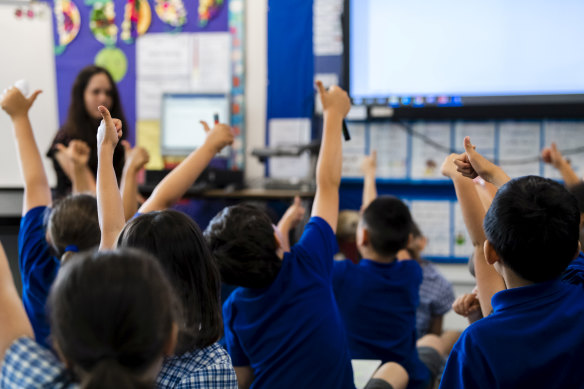By Lucy Carroll
Almost half of year 1 students in NSW are not reading as well as they should, with results from the latest phonics check showing a vast achievement gap between advantaged students and their disadvantaged peers.
Results from the second statewide check are stable when compared with the previous year, showing 55.1 per cent of students reached the expected reading level by scoring 28 correct answers out of a list of 40 words.

Overall in NSW, 55 per cent of students achieved at or above the expected level.Credit: Rhett Wyman
Across the state, year 1 students scored an average of 26 correct answers. The check involves teachers spending five to seven minutes with each child to listen to how they blend and sound out letters and letter combinations.
NSW Education Minister Sarah Mitchell said that given the challenges of last year, the results signalled that year 1 students have held steady and are on track.
“The year 1 phonics check is all about helping teachers understand their students’ reading progress and what support they need next,” Mitchell said.
“This check means more students will find themselves able to read well throughout their lives and is why we are already seeing improvements in results since our trial check in 2020.”
Overall, 55 per cent of students achieved at or above the expected level, answering 28 or more questions correctly, a slight dip from 57 per cent in 2021.
About 74 per cent of students from advantaged backgrounds – with highly educated and professional parents – met or exceeded expected levels compared with 31 per cent of students from the most disadvantaged backgrounds.
Less than a quarter of children in remote areas met the expected reading level compared with 58 per cent in major cities.
The second mandated statewide check was completed during term 3 last year over four weeks. Although results from the 2021 check were 1.6 per cent higher, caution should be taken when comparing results due to a longer assessment window and some students being able to take the test later in the year.
Jennifer Buckingham, a phonics advocate and director of strategy at reading company MultiLit, said that while the “results are uncomfortable” they show why the phonics check is vital. “It really provides evidence we need to keep improving,” she said.
“Even taking into consideration COVID and the flu earlier in the year, it would be reasonable to expect a bit of improvement, given we’ve had the implementation of a new syllabus which has a strong focus on phonics,” Buckingham said.
Primary schools intensified their focus on literacy and numeracy in 2022 as part of an overhaul to the state curriculum that places a heavier emphasis on foundational skills in early schooling.
The new kindergarten to year 2 syllabus that mandates the teaching of phonics when teaching children to read was rolled out across all schools this year.
At Guise Public School in Macquarie Fields more than 65 per cent of students achieved at or above the expected level, a significant jump from 32 per cent in 2021. On average, students answered 10 more questions correctly when compared with 2021 results.
The former principal at Guise Public School, Megan Predl, pointed to the school’s specialised learning program for pre-kindergarten students as critical in teaching some early literacy skills before children start kindergarten.
“Once at school, those students needing extra reading help are targeted for intervention and are placed on a school program which involves small group instruction in a specific focus area over five weeks,” Predl said.
“We’ve also really focused on professional learning for teachers. It is vital teachers know where their students are at and how to find the gaps and put them in place to improve.”
The phonics screening check – based on a test first introduced in the United Kingdom – evaluates whether children have understood the fundamentals of using phonics to decode 40 words and then provides extra support if they have not.
In 2022, the phonics check was completed by about 65,000 students across more than 1600 primary schools. The students tested began kindergarten during the pandemic and have experienced remote learning for more than 30 per cent of their schooling.
The test consists of 20 real words and 20 pseudowords such as “klom” to make sure students use their knowledge of letters to blend through the sounds in the word and read it correctly.
Mitchell said it was particularly pleasing to see that the percentage of Aboriginal students who met the expected level, or scored higher than average, increased slightly this year. About one-third of Aboriginal students met the expected achievement level.
Buckingham said with all the resources available it was not unreasonable to expect the vast majority of children would meet the benchmark if they have had effective phonics instruction.
“We are not setting a high and unrealistic expectation, and we can expect better than this.”
The NSW government has committed $16 billion to deliver a universal pre-kindergarten for every child in the year before school.
The Morning Edition newsletter is our guide to the day’s most important and interesting stories, analysis and insights. Sign up here.